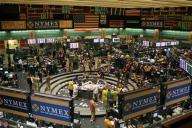Related articles and videos:
– Fortis Bank Predicts US Financial Market Meltdown Within Weeks
– Barclays warns of a financial storm as Federal Reserve’s credibility crumbles
– Jim Rogers: Avoid The Dollar At All Costs
– Ron Paul on Iran and Energy June 26, 2008
– Marc Faber: ‘Misleading’ Fed Should Let Banks Fail
NEW YORK (Reuters) – The Dow and S&P 500 were little changed on Monday on the final trading day of the second quarter as record oil boosted energy shares, offsetting weak financial stocks amid nagging concerns of further credit losses.
But even with the pause on Monday, the Dow and S&P posted their worst one-month drop since September 2002. The Dow also suffered its worst first half since 1970.
The Nasdaq ended the session lower, hurt by a drop in the shares of Yahoo as it battles with shareholders after takeover talks with Microsoft fell apart.
Shares of Exxon Mobil and Chevron lent support to the Dow and the S&P 500. Oil jumped to a record of $143.67 a barrel on rising Israeli-Iranian tensions but then pulled back to trade only slightly higher.
Financial shares fell on more negative analyst comments.
Veteran analyst Richard Bove said Merrill Lynch will be forced to raise equity in the third quarter and may sell 20 percent of its holdings in Bloomberg for $1 billion. Ladenburg Thalmann’s Bove also cut his 2008 and 2009 earnings estimates for Morgan Stanley.
Trading was erratic, which traders blamed on positioning by
portfolio managers making final adjustments at the end of the quarter.
“I’m sure with the continuing meltdown, there are a number of managers out there who don’t want to be seen with certain financials on their books or even being as heavily weighted as they were,” said Matt Kaufler, portfolio manager and equity analyst at Clover Capital Management in Rochester, New York.
“Many have tried to catch the proverbial falling knife, but it’s eluded everybody, ourselves included.”
The Dow Jones industrial average gained 3.50 points, or 0.03 percent, to end at 11,350.01. The Standard & Poor’s 500 Index was up 1.62 points, or 0.13 percent, at 1,280.00. The Nasdaq composite index was down 22.65 points, or 0.98 percent, at 2,292.98.
For the month, the Dow fell 10.2 percent, the S&P 500 fell 8.6 percent and the Nasdaq ended down 9.1 percent.
For the quarter, the Dow dropped 7.4 percent, the S&P 500 lost 3.2 percent and the Nasdaq ended up 0.6 percent. The Dow ended 19.8 percent down from its October high, just short of a bear market.
The S&P financial index dropped 1.5 percent, while shares of insurer American International Group and Citigroup, the largest U.S. bank, ranked among the heaviest drags on the S&P 500.
Shares of AIG fell 4 percent to $26.61 and Citigroup declined 3 percent to $16.70. Lehman Brothers shares fell 11 percent to $19.81. Morgan Stanley’s shares fell 1.7 percent to $36.07 and Merrill’s shares shed 3 percent to $31.71.
Wachovia Corp, the fourth-largest U.S. bank, fell 4.2 percent to $15.53 after the New York Post said Prudential Financial Inc could force the bank to buy its stake in their Wachovia Securities joint venture. A Wachovia spokeswoman said she could not comment on what Prudential may or may not do.
Yahoo shares fell 3.1 percent to $20.66 as it sought to rally shareholder support for its board of directors and management, calling billionaire Carl Icahn’s plan “ill-defined” for the future of the Internet company.
Exxon Mobil Corp rose 1.8 percent to $88.13 and Chevron Corp climbed 1.4 percent to $99.13, both on the New York Stock Exchange.
On the economic front, a report showed business activity in the U.S. Midwest contracted in June for a fifth straight month but activity was not as weak as analysts feared.
Another report showed the downturn in New York City business activity continued in June after May’s brief pause.
Trading was moderate on the New York Stock Exchange, with about 1.61 billion shares changing hands, below last year’s estimated daily average of roughly 1.9 billion, while on Nasdaq, about 2.10 billion shares traded, also below last year’s daily average of 2.17 billion.
Declining stocks outnumbered advancing ones by a ratio of about 3 to 2 on the NYSE and by 2 to 1 on Nasdaq.
(Additional reporting by Cal Mankowski; Editing by Kenneth Barry)
By Kristina Cooke
Mon Jun 30, 2008
Source: Reuters
